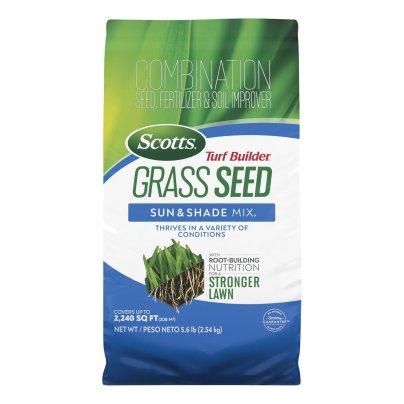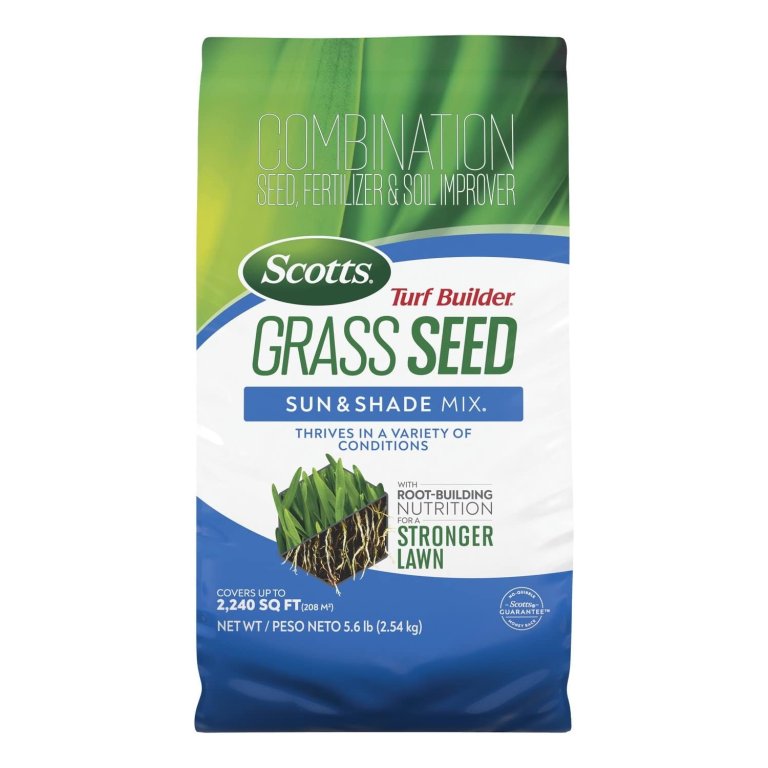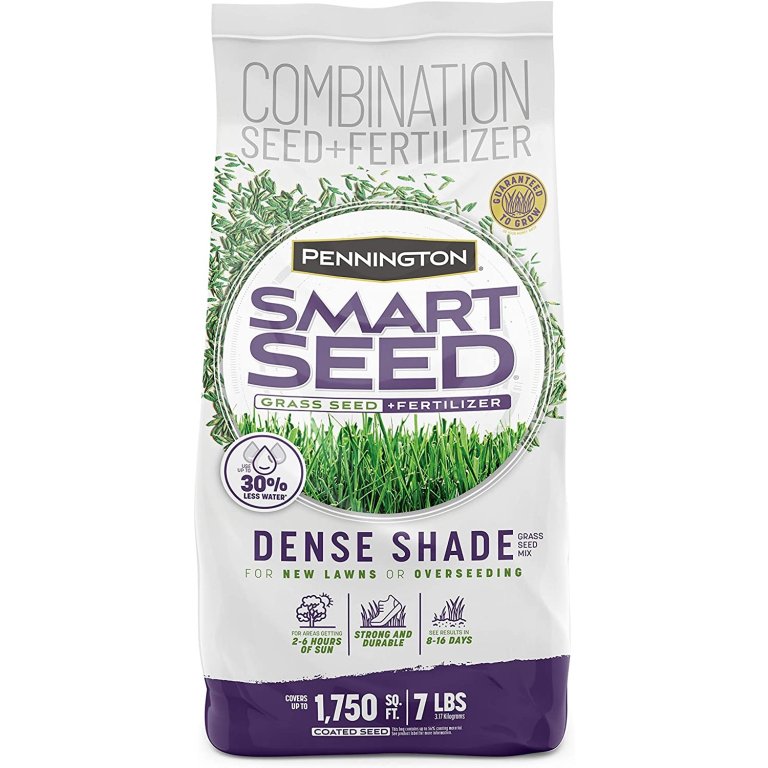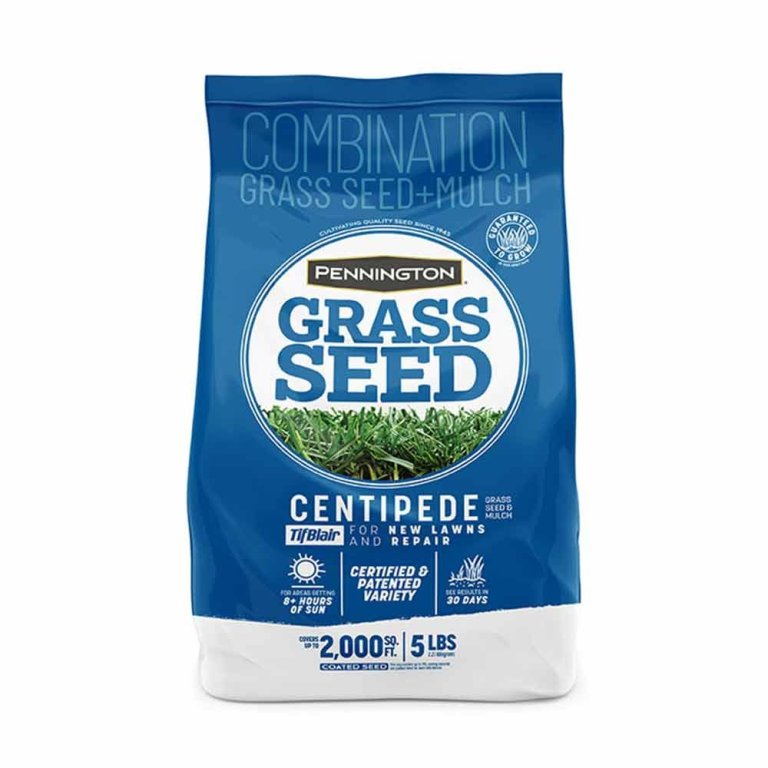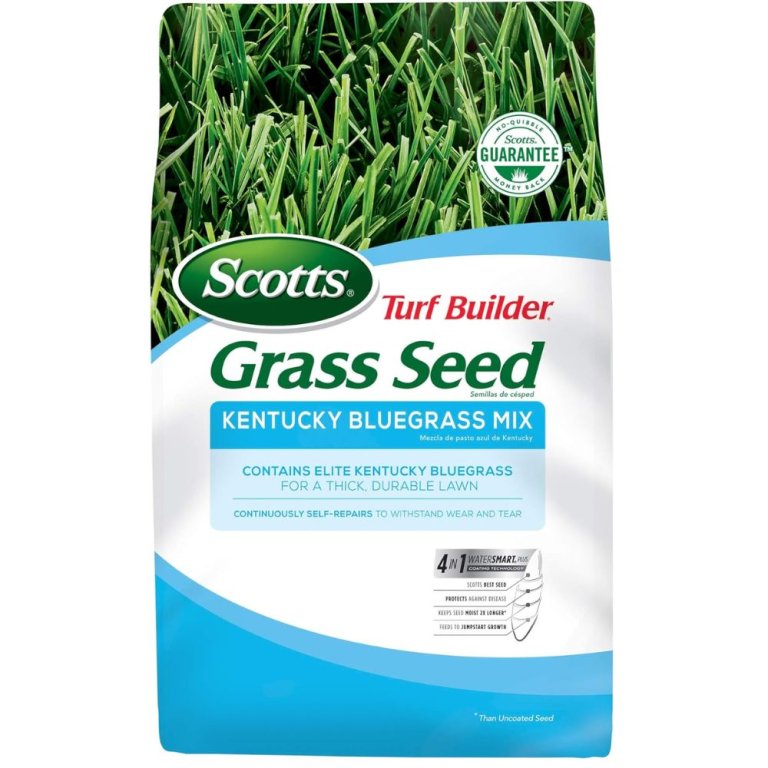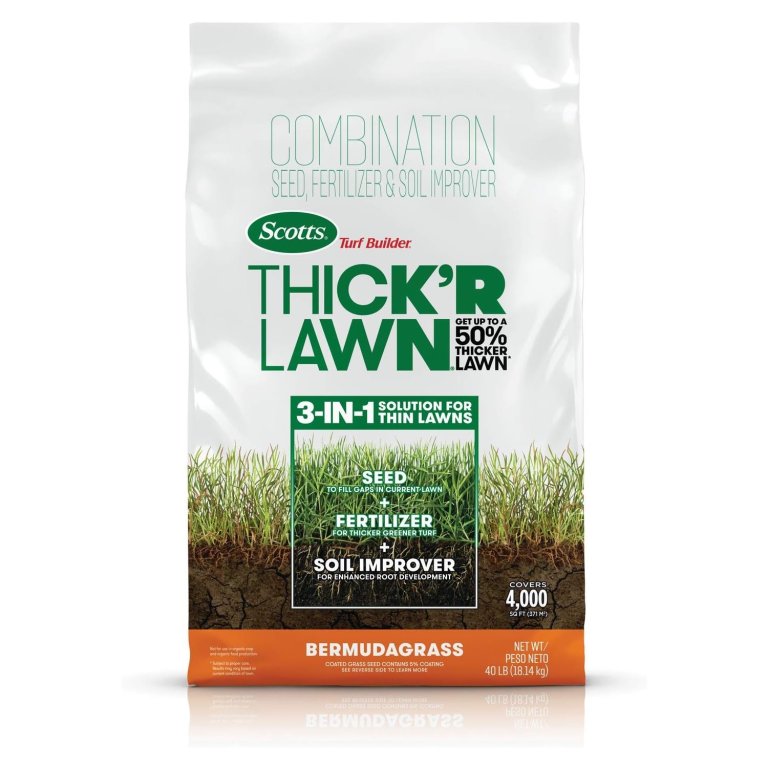
We may earn revenue from the products available on this page and participate in affiliate programs. Learn More ›
The best grass seed for overseeding a lawn will depend on the existing type of grass, the prevailing climate, and the soil type. After a few years, even the best-kept lawns can start to look sparse and worn out due to drought, under-watering, overwatering, or even growing a grass variety that’s unsuited to the region.
Overseeding a lawn with a superior variety of grass seed at least once every 3 years will keep the yard looking its best while helping it resist drought and disease. Because grass variety is regional and climate-based, we recommend Scotts Turf Builder Grass Seed Sun & Shade Mix for cooler regions and Pennington Smart Seed Sun and Shade Tall Fescue for warmer climates. Both seed mixes feature excellent disease and drought resistance and will work for most areas in their respective regions.
All grass seeds we recommend for overseeding are specific to the region they will grow best and feature good disease and drought resistance. Using the right grass seed for your lawn means you’ll be enjoying a beautiful lawn all season.
- BEST FOR COOL CLIMATES: Scotts Turf Builder Grass Seed Sun & Shade Mix
↓ Jump to Review - BEST FOR WARM CLIMATES: Pennington Smart Seed Sun and Shade Tall Fescue
↓ Jump to Review - BEST CENTIPEDE: Pennington Tifblair Centipede Grass Seed
↓ Jump to Review - BEST BLUEGRASS: Scotts Turf Builder Kentucky Bluegrass Mix
↓ Jump to Review - BEST TALL FESCUE: Sunday Fescue Rescue Grass Seed
↓ Jump to Review - BEST BERMUDA GRASS: Scotts Turf Builder Thick’R Lawn Bermudagrass
↓ Jump to Review - BEST PERENNIAL RYEGRASS: Pennington Smart Seed Perennial Ryegrass
↓ Jump to Review

Before You Buy Grass Seed
Grass seed producers often coat seeds with a fungicide to enhance germination by preventing harmful fungi from damaging them before they sprout. While this treatment helps ensure more seeds thrive, environmental concerns may arise about using fungicides. To mitigate these concerns, it is essential to store the seeds in a cool, dry place and strictly adhere to the manufacturer’s directions for use. This approach minimizes any unnecessary environmental impact and maximizes the health benefits of growing natural grass.
Product Comparison
| Drought tolerance | Overseeding coverage | Climate | |
| Scotts Turf Builder Grass Seed Sun & Shade Mix | Medium | Up to 960 square feet (2.4-pound bag) | Mid-to northern zones |
| Pennington Smart Seed Sun and Shade Tall Fescue | High | Up to 1,000 square feet per (4-pound bag) | Mid- to southern zones |
| Pennington Tifblair Centipede Grass Seed | High | Up to 5,000 square feet (5-pound bag) | Deep southern zones (not including South Florida) |
| Scotts Turf Builder Kentucky Bluegrass Mix | Medium | Up to 2,000 square feet (3-pound bag) | Northern zones |
| Sunday Fescue Rescue Grass Seed | High | Up to 1,000 square feet (2-pound bag) | Northern transitional zones |
| Scotts Turf Builder Thick’R Lawn Bermudagrass | High | Up to 1,200 square feet (12-pound bag) | Deep southern zones |
| Pennington Smart Seed Perennial Ryegrass | Low | Up to 1,000 square feet (4-pound bag) | Northern and transition zones |
Our Top Picks
Selecting a grass seed can be challenging, as there are so many options on the market. To make the search easier, the following grass seeds are among the best available. Each is designed for a specific region and lawn, but each is a standout in its category.
Best Overall For Cool Climates
Scotts Turf Builder Grass Seed Sun & Shade Mix
What We Like
- Thrives in full sun and shade
- Spreads quickly for durable lawn
- Fine bladed texture, aesthetically pleasing
What We Don’t Like
- Requires consistent, frequent watering initially
Product Specs
- Drought tolerance: Medium
- Overseeding coverage: Up to 960 square feet (2.4-pound bag)
- Climate: Mid-to northern zones
Scotts Turf Builder Grass Seed Sun & Shade is acclaimed for its versatility and effectiveness in both sunny and shaded areas, making it an ideal choice for overseeding diverse landscapes. This seed mix promises to thrive in extreme conditions, including dense shade and full sun, and it features a fine-bladed texture with good drought resistance.
Scotts Turf Builder has an aggressive spread and thickening ability, contributing to a more durable lawn. Users report significant lawn health and appearance improvements, with faster germination times ranging from 10 to 15 days, depending on weather conditions. However, the seed requires consistent watering, especially in the initial stages of growth, which could be a drawback for regions with water use restrictions.
Scotts Turf Builder mix is a robust performer in cool climates, where sun exposure can be variable. Its vigorous growth in both sun and shade, coupled with its resilience to changing weather conditions, underscores its ability to maintain year-round greenery.
Get the Scotts Sun & Shade grass for overseeding at Amazon.
Pennington Smart Seed Sun and Shade Tall Fescue
What We Like
- Thrives in sun and shade
- Excellent disease resistance
- Strong drought tolerance
- Includes growth-accelerating fertilizer
What We Don’t Like
- Higher price than other seeds
- Unsuitable for deep southern climates
Product Specs
- Drought tolerance: High
- Overseeding coverage: Up to 1,000 square feet per (4-pound bag)
- Climate: Mid- to southern zones
The Pennington Smart Seed Sun and Shade tall fescue seed is an excellent choice for homeowners in warmer climates who want a resilient and attractive lawn. This grass seed mix is designed to thrive in sunny and shaded areas, making it highly adaptable to varying garden exposures. Its deep roots enhance drought resistance, significantly reducing the need for frequent watering even in high temperatures, which is a major advantage for water conservation efforts.
However, the initial cost of this seed mix can be higher than some other varieties due to its specialized breeding for drought and shade tolerance. Additionally, the dense growth of tall fescue might require more frequent mowing compared to less vigorous varieties, which could be a consideration for those seeking low-maintenance options.
Overall, Pennington Smart Seed Sun and Shade offers a robust solution for warm climate lawns, ensuring lush, green grass that is both durable and visually appealing. Its benefits of adaptability and drought tolerance outweigh the minor concerns related to cost and maintenance, making it a top recommendation for those in warmer regions.
Get the Pennington Smart Seed Sun and Shade grass seed for overseeding at Amazon, The Home Depot, or Walmart.
Best For Centipede Lawns
Pennington Tifblair Centipede Grass Seed
What We Like
- Enhances lawn appearance with dense mat
- Reduces mowing frequency; less maintenance
- Suppresses weeds; blocks sunlight
What We Don’t Like
- Slow growth hinders quick establishment
Product Specs
- Drought tolerance: High
- Overseeding coverage: Up to 5,000 square feet (5-pound bag)
- Climate: Deep southern zones (not including South Florida)
Pennington TifBlair centipede grass seed is an exceptional choice for buyers looking to establish or rejuvenate a centipede grass lawn. Known for its low maintenance needs, this grass variety requires minimal mowing and care once established, thanks to its slow growth and dense coverage. This product efficiently creates a lush, green carpet that enhances the aesthetic of any southern landscape.
However, despite its many advantages, TifBlair centipede grass seed thrives primarily in sunny environments and may struggle in shaded areas. Moreover, it is not the fastest grower, which could be a concern for those looking to establish a lawn quickly. Overall, while it may take patience to see full results, the end result of a resilient and attractive lawn makes Pennington TifBlair a top contender in the market for centipede grass.
Get the Pennington Tifblair grass seed for overseeding at Lowe’s.
Best For Bluegrass Lawns
Scotts Turf Builder Kentucky Bluegrass Mix
What We Like
- Disease-resistant, high-traffic tolerant bluegrass
- Versatile for sun and shade areas
- Fine texture, medium drought resistance
What We Don’t Like
- Lower lawn disease and pest tolerance
Product Specs
- Drought tolerance: Medium
- Overseeding coverage: Up to 2,000 square feet (3-pound bag)
- Climate: Northern zones
Bluegrass enthusiasts will want to check out Scotts Kentucky bluegrass mix, which provides a fine-blade grass texture and a measure of drought resistance in a true bluegrass seed. A 3-pound bag of Scotts Kentucky bluegrass mix will overseed up to 2,000 square feet of existing lawn and can be used in sunny spots and areas with light shade. This mix grows best in the northern half of the country, and it is moderately drought-resistant.
Get the Scotts Kentucky bluegrass seed for overseeding at Amazon or The Home Depot (5-pound bag).
Sunday Fescue Rescue Grass Seed
What We Like
- Withstands heavy foot traffic
- Fast germination and growth
- Resilient against drought
What We Don’t Like
- Performs poorly in cooler temperatures and wet climates
Product Specs
- Drought tolerance: High
- Overseeding coverage: Up to 1,000 square feet (2-pound bag)
- Climate: Northern transitional zones
The Sunday Rescue Fescue grass seed is well known for being low maintenance and providing high rewards. Sunday is a lawn subscription service that sends everything you need for a healthy lawn. They also feature a whole line of grass seed and other lawn products. Fescue Rescue is an ideal choice for lawns that face heavy foot traffic, heat, and drought conditions. This grass seed is specially designed to thrive in challenging environments, ensuring strong growth and durability. It’s perfect for areas where other grass types might struggle, giving users a resilient, green lawn with minimal effort. However, there may be better choices for cooler, wetter climates where different types of grass may perform better.
Get the Sunday grass seed for overseeding at Sunday.
Scotts Turf Builder Thick'R Lawn Bermudagrass
What We Like
- Seeds, fertilizer, soil improver in one
- Designed for lawns with bare spots
- Promotes deeper root growth
What We Don’t Like
- Bermudagrass grows aggressively and may invade garden beds
Product Specs
- Drought tolerance: High
- Overseeding coverage: Up to 1,200 square feet (12-pound bag)
- Climate: Deep southern zones
Scotts Turf Builder Thick’R Lawn Bermuda grass seed is a three-in-one solution for lawn improvement. It includes grass seed, fertilizer, and soil improver, designed to fill gaps in an existing lawn while feeding and thickening new and existing grass areas. This product makes lawn maintenance easier by combining all the necessary components into one package. It is especially helpful for those who want to improve their lawns without using multiple products. However, proper seed germination requires careful application and suitable growing conditions. Using it incorrectly or in inappropriate weather can lead to less-than-ideal results. Bermuda grass can alsogrow quite aggressively, so careful maintenance may be necessary to keep it out of flower beds.
Get the Scotts Thick’R Lawn grass seed for overseeding at Amazon or The Home Depot.
Pennington Smart Seed Perennial Ryegrass
What We Like
- Suitable for high foot traffic areas
- Enhanced resistance to lawn diseases
- Stays green year-round in suitable climates
What We Don’t Like
- High water requirements; not drought-friendly
Product Specs
- Drought tolerance: Low
- Overseeding coverage: Up to 1,000 square feet (4-pound bag)
- Climate: Northern and transition zones
Pennington Smart Seed perennial ryegrass is well known for its fast germination and developing a dense, fine-textured lawn. This high-quality blend of ryegrass varieties is designed for easy establishment, providing a resilient turf with good tolerance to foot traffic, making it an ideal choice for areas with high activity.
Perennial ryegrass is highly versatile. It can be used as a warm-weather turfgrass in northern and transitional climates or as a cool-weather grass in southern climates. However, perennial ryegrass generally requires more water and maintenance compared to other grass types, which could be a concern in areas with water use restrictions.
Get the Pennington Ryegrass seed for overseeding at Amazon or The Home Depot.
Jump to Our Top Picks
How We Chose the Best Grass Seed for Overseeding
Extensive product research went into selecting this roundup of the best grass seed for overseeding. While grass seeds are limited to just a few well-known producers, today’s hybridized seeds and revolutionary seed formulas can produce lush, resilient lawns.
We tapped the experts at Sod Solutions to help us with tips for choosing the best grass seeds for overseeding. Valerie Smith, content strategist, has spent years with grass experts at Sod Solutions and shared her insights. She says when it comes to grass seed, it’s best to “choose a grass seed that aligns with your local climate and region—for cool season grasses like fescue or Kentucky bluegrass in northern areas and warm season grasses like Bermuda grass or centipede grass in southern regions.” The best grass seed will thrive in the specific region where it’s planted. “For best results, match the new seed to your lawn’s existing grass type when overseeding to maintain a uniform appearance in your lawn,” she advises.
We selected products based on brand reputation, the quality of the seeds—including the percentage of weed seeds in the mix—and how well each performed in its stated category or region. We opted for seeds that will strengthen and enhance existing lawns.
What to Consider When Choosing Grass Seed for Overseeding
For the best results, shoppers will want to choose a grass seed type that will grow well in their specific yard. Consider the amount of sunlight the lawn receives, the general climate, and the kind of grass desired. Additionally, the size of the yard and the seed’s coverage rate will play a role in how much seed is needed to overseed the lawn.
Types of Grass Seed
Various grass seeds are used in the United States, each of which thrives in a different region. For example, grass seed that grows well in the Pacific Northwest may not grow in southern climates. In general, more cool-season grasses are grown from seed than warm-season grasses. Several warm-season grasses, such as St. Augustine, are propagated by plugs rather than seeds, so overseeding is more common in regions with cool winters.
- Bermuda grass: Strictly a warm-weather grass, Bermuda grass seed produces a lush lawn in sunny yards and is drought-tolerant. It doesn’t like cold weather, and it doesn’t tolerate deep shade.
- Centipede: This warm-season turfgrass is widely used in the southern United States due to its adaptability to poor soils and slow growth, reducing the need for frequent mowing.
- Fescue: Among the fastest-growing grasses, fescue features several types with various textures. It’s prized for its drought resistance and ability to withstand moderate traffic. It also grows in both sunny and shady spots.
- Kentucky bluegrass: Dense and durable, Kentucky bluegrass is a self-spreading, disease-resistant turf option that will tolerate cold temperatures. It’s not as drought- resistant as fescue, but it provides a lush lawn that tolerates high traffic.
- Perennial ryegrass: Useful for overseeding moderately cool- or warm-season grasses, perennial ryegrass requires a lot of water and doesn’t grow well in frigid climates.
Climate and Sun Exposure
Researchers and seed manufacturers are busy hybridizing grass seed types to thrive in specific climates, such as the warm Southeast, cooler Northeast, or the rainy West Coast, and to grow in harsh sun or dense shade. Most grass seed varieties grow well with full to partial sun, but new and improved versions will tolerate shade as well.
Buyers can often find specialized seeds within the same seed family. For instance, several options are available just within the fescue grass-seed type. These include hard fescue that grows in colder climates and high elevations, creeping fescue that will grow even in deep shade, and fast-growing tall fescue grasses that withstands heavy traffic but doesn’t like hot weather.
Coverage Area
The amount of seed necessary for overseeding a lawn depends on the type, whether the seed is coated or bare, and the overall condition of the existing lawn. The best rule of thumb is to follow the manufacturer’s coverage recommendations that appear on the bag of seeds.
The coverage area for coated grass seeds is not as high as uncoated seeds because coated seeds are larger, so fewer seeds are present per pound. Spread rate varies by grass type as well, and this will appear on the package. K31 fescue, for example, has a spread rate of 5 to 10 pounds per 1,000 feet, with 10 pounds being the average for establishing new lawns and 5 pounds as the average for overseeding. For the best results, follow the spread rate suggested by the manufacturer.
Low Maintenance
Keeping a lawn healthy and beautiful requires diligence and proper attention. Achieving a maintenance-free lawn isn’t possible, but home gardeners can reduce the amount of mowing, fertilizing, dethatching, and watering by choosing to overseed with a grass variety that grows well in the specific region. Generally, a low-growing grass variety, such as centipede grass, requires fewer mowings than a tall-growing variety, such as fescue.
If watering the lawn is a particularly tedious task, a drought-tolerant variety, such as Bermuda grass, is among the best options for a low-maintenance yard in warm, sunny climates. What is considered low maintenance in one region may be high maintenance in another, so consider choosing a variety that’s well suited or native to the area.
Tips on How to Overseed a Lawn
Overseeding an existing lawn is much simpler than putting in a new lawn from scratch because the grass is already established, and there’s no need to till or rake the soil. For the best germination results, consider the following tips.
- Mow the lawn first and bag the clippings. Shorter grass will allow the new seedlings to receive more sunlight.
- Rake the yard to remove leaves or dethatch if a heavy layer of thatch (organic matter that forms a mat) is present at ground level.
- Add soil amendments before overseeding if necessary. The best way to do this is to have the soil tested by a local extension agency to determine if it lacks certain nutrients and then apply them before overseeding.
- Add seeds to a drop spreader or a broadcast spreader and set the distribution rate to match the package’s recommended spread rate.
- Water daily to keep the seeds moist—but not so much that the ground is soggy or water is pooling.
Benefits of Overseeding
The most significant result of overseeding is the ability to revive a lawn, but there are some other benefits as well.
- Dense grass is less susceptible to soil erosion because the additional grass roots hold the soil in place.
- Overseeding with today’s improved seed varieties will boost lawn health and make the grass more resistant to disease and insects.
- A healthy lawn boosts curb appeal and is a strong selling point if a house is on the market.
- The healthier the lawn, the less likely weeds are to get a foothold. This reduces the need for frequent applications of chemical herbicides, which is more beneficial for the environment.
FAQs
While overseeding a lawn is a relatively straightforward project, grass seed can be pricey, depending on the type, so it’s normal to have a few questions. Below are answers to some of the more popular questions about overseeding lawns.
If you’re overseeding cool-season grasses, such as fescue, seed in early fall, which will give the new seedlings time to develop before winter. For seeding warm-season grasses, such as Bermuda, overseed in late spring when soil temperatures are around 65 degrees Fahrenheit.
Water the lawn daily for the first 2 to 3 weeks after overseeding to provide adequate moisture. Seeds germinate after they have received this daily dose of water. Do not mow until the new seedlings have reached the height you usually mow.
This will vary depending on the type of seed and whether the seed is coated. The seed’s spread rate will be listed on the product packaging.
Yes, a drop spreader or a broadcast spreader are suitable for overseeding the lawn. Overseeding lawn equipment also includes machines that make slits in the soil and then deposit the seeds in the slits. These machines, called “grass drills,” can be rented from landscape rental companies.
Covering grass seed is traditionally limited to newly seeded lawns, not overseeded lawns. If you’re seeding bare patches where no grass is growing, feel free to cover the seed lightly with a layer of loose straw or use a seed product that contains mulch in the mix.
Perennial ryegrass is a mid-to-cool season grass that can be grown by itself or mixed with other cool-season grasses. Annual ryegrass may be found in warm-season mixes because it germinates quickly and provides a cover for the slower-to-germinate warm-season grasses.
The duration for grass to grow from seed varies depending on the type of grass and the environment. Cool-season grasses such as Kentucky bluegrass and fescue typically can sprout within 7 to 14 days. In contrast, warm-season grasses may take longer to germinate, depending on soil temperature and moisture levels.
